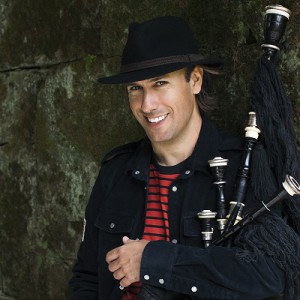Carlos Núñez
 “…if it’s possible to become a pop star playing traditional music on bagpipes and recorder, Núñez could be the man,”-Los Angeles Times
“…if it’s possible to become a pop star playing traditional music on bagpipes and recorder, Núñez could be the man,”-Los Angeles Times
Few pop stars pack the energy, virtuosity, imagination, daring, and charisma into their concerts and recordings as Galician multi-instrumentalist Carlos Núñez does.
He is the world’s most famous player of the gaita, the bagpipes of Galicia, Spain’s northwest, Atlantic Ocean-abutting region rich in vibrant, uniquely expressive Celtic traditional music. Nevertheless, several decades ago Paddy Moloney, leader of the celebrated Irish traditional band the Chieftains, called Galicia “the unknown Celtic country,” implying that traditional music as exciting as Galicia’s was overdue for a global breakout in awareness and acclaim. Like the Chieftains, who became Ireland’s foremost ambassadors of Irish traditional music by spreading its appeal internationally, Carlos Núñez has become Galicia’s foremost traditional music ambassador by doing the same. He takes that important responsibility very seriously but without a shred of self-importance.
Born in 1971 and raised in the Galician port of Vigo, where he initially picked up the gaita at age eight, Carlos both embodies and reflects the irrepressible spirit of his native music. But he also understands the pitfalls of traditional music becoming incrementally complacent in approach and insulated from innovation. Under those conditions, even the heartiest music can eventually slip into predictability. Carlos respects and seeks to safeguard Galicia’s musical legacy while also skillfully exploring fresh, fascinating realms of possibility for it.
In 1994 The Chieftains, whom Carlos had initially met at Lorient’s Inter-Celtic Festival, invited Carlos to perform with them at New York City’s Carnegie Hall. It was a highly auspicious U.S. concert debut by him, and since then he has toured and recorded several times with the Chieftains, including on their albums Voice of Ages (2012), San Patricio (2010), The Long Black Veil (1995), and Santiago (Carlos worked closely with Moloney in developing this Galician-sparked, Spanish-focused project from 1996). The latter two CD’s earned Grammy awards, and Carlos as a solo artist received Latin Grammy nominations for Os Amores Libres in 2000 andMayo Longo in 2001.
The gaita is Galicia’s signature sonic symbol, dating back at least to the 11th century, and Carlos’s utter mastery of this bagpipe has been integral to its rising popularity inside and outside Spain. His ability in fingering the chanter to bend, extend, or cut notes, sustain and change tempos, explore harmonic nuances and tonal colors, and complement and counterpoint other musicians’ playing is nothing short of astonishing, and those musical hallmarks are not limited to his playing of the gaita.
At the Royal Conservatory in Madrid, Carlos took lessons on the recorder, for which he received the highest possible grades, but it was his subsequent self-training that raised his proficiency level to studio and concert-hall quality. “The recorder is a very personal, intimate instrument,” Carlos pointed out. “The gaita has drones, so its sound is powerfully earthy. With the recorder, you can fly like a bird.”
Carlos’s instrumental arsenal also includes the ocarina, assorted whistles, Scottish highland pipes, uilleann (Irish) pipes, bombarde (a kind of Breton oboe), biniou koz (Breton bagpipes), and pastoral pipes (18th-century precursor of the uilleann pipes). This impressive panoply of instruments provides Carlos and his audiences with a variety of textures matched to that of his repertoire.
On Inter-Celtic, Carlos’s range is again exemplary and exhilarating, abetted by his own core band and another star-studded roster of special guests. Among the other 14 standout tracks are “Vento das Cies” (exuberant muiñeira, or Galician traditional jig, featuring button accordionist Sharon Shannonand bouzouki-bodhrán player Dónal Lunny from Ireland), “Gavotte/Pandeirada” (atmospheric, animated pairing of harper Alan Stivell’s Breton-steeped composition and a Galician tune), “Two Shores” (poignant Galician melody principally played by U.S. guitar ace Ry Cooder and Carlos that came from a 19th-century Galician zarzuela, or folk opera), “Is the Big Man Within?” (lively Irish traditional jig played by Carlos with the Irish traditional band Altan), and “Over Nine Waves” (Carlos’s beautiful, contemplative composition inspired by the legendary story of the ancient Milesians, who sailed from northern Spain to Ireland and became ancestors of the Celtic populace there, a number of whose descendants would emigrate centuries later to northern Spain and especially Galicia to escape hardship).
Building strong, durable bridges between distinct yet kindred Celtic traditions with passion and care, he remains a global force to be reckoned with in all of music today.
www.carlos-nunez.com
www.facebook.com/pages/Carlos-Núñez/

